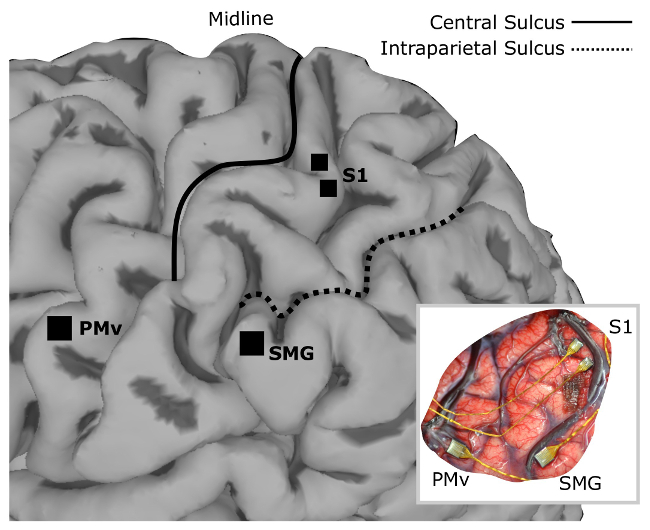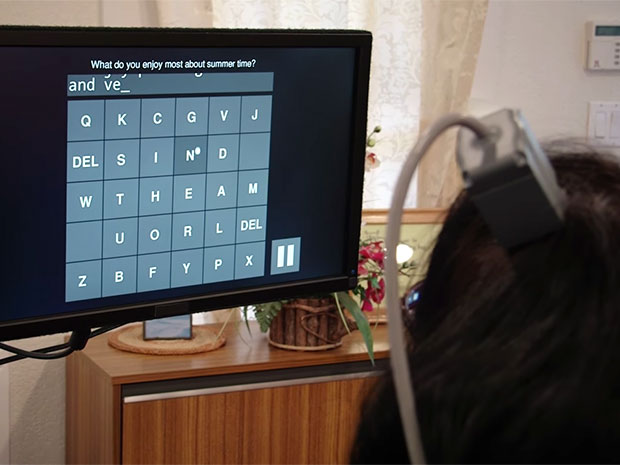A paralyzed person could feel his body again.
One and a half years after the spinal cord injury, the person was again able to feel the touch. The 32-year-old paralyzed patient was helped by technology at the junction of prosthetics and microsurgery. The results of this work, scientists from the California Institute of Technology April 10 published in the journal eLIFE.

Location of implants implanted in a patient on a 3D-model of the left hemisphere. 96-channel electrodes were implanted into the premotor cortex (PMv) and supramarginal gyrus (SMG), and 48-channel electrodes into the primary somatosensory cortex (S1)
According to the World Health Organization annually from 250 thousand to 500 thousand people around the world stop walking and lose their tactile sensations due to spinal cord injuries.
')
The first attempts of scientists to restore the musculoskeletal system were made more than 20 years ago. Research in the field of restoring the functioning of the spinal cord was conducted by Professor Gregoire Curtin, an English scientist Jeffrey Reitman. But the breakthrough successes in this area have been talked about only in recent years.
One of the latest achievements belongs to researchers from Caltech under the leadership of neurosurgeon Richard Andersen. Scientists implanted two groups of microelectrodes into the cerebral cortex of a paralyzed person. A 32-year-old patient who was completely paralyzed as a result of a spinal cord injury (occurred 1.5 years ago) took part in the experiment.
With similar injuries, the connection between the neurons of the somatosensory zone and the receptors on the skin occurs. As a result, the stimulus that enters the receptors does not reach the brain, and the person stops responding to tactile sensations. But the brain itself remains unscathed.
In the course of the experiment, researchers stimulated neurons in the brain area — small current discharges were applied to the electrodes. Neurons responded to only 46 of the 96 electrodes. At the same time, the signal was constant and there were no fictitious positives, and the reaction resembled a natural one. During the experiment, the patient was able to experience the tactile sensations that he felt before the injury. It seemed to him that he was shaking his hand, raising it, patting him on the shoulder.

Table of the results. Best of all imitated the sensations of squeezing and pressing. Worst of all - goosebumps.
The researchers plan to integrate the development into an existing neural prosthesis. A similar experience with the laboratory Andersen already has. In 2015, they created a model for connecting a prosthetic robotic arm with electrodes. Thanks to this, a paralyzed person could take a cup with a prosthesis and drink from it.
Back in 2012, the Israeli company ReWalk Robotics created an exoskeleton that helps a person paralyzed from the waist down to enjoy walking again. In fact, it is an independent robot attached to the back and legs of a person. It can be controlled using external buttons, a special joystick or using a computer, phone and tablet.
The ReWalk system is equipped with servo drives located in the “hips” and “knees”, which enable walking. The device also includes accelerometers to track the position of the limbs of the person and the whole body as a whole.
In the exoskeleton, a person can move at a speed of 2.6 km / h. The weight of the device is 25 kg. One battery charge lasts for 180 minutes of work. The cost of the system is $ 77,000.
German neuroscientist Nils Birbaumer from the Wiss Center has developed a device that allows completely paralyzed people to communicate. The device has a neurocomputer interface that records the answers "yes" and "no" from patients who are deprived of voluntary muscle movements. The technology is based on measuring brain activity and blood flow.
The device is worn on the head and transmits signals from the human brain using infrared spectroscopy. Read more about the development
Doctors believe that using the device, you can determine whether a paralyzed person is conscious or not. In the future, they plan to create a technology that will enable patients to communicate more fully, not limited to the answers "yes" and "no."
Colleagues Birmbauer from Stanford, led by neurosurgeon Jamie Henderson, created a technology by which patients with the syndrome of "locked man" can communicate using printed text. True, this will require surgery: a tiny implant is inserted into the patient’s cortex, responsible for movement.
A number of implant electrodes reads signals from neurons and transmits them to a special computer. BrainGate decoding software interprets the signal and converts it into a typing command.
The computer is equipped with a virtual keyboard. The person with the electrode must type the text mentally - imagine how he moves his hand and presses the virtual button. Significant minus - the speed of "print": only 8 words per minute.

MoreGrasp uses simpler technology without invasive intervention. She creates a prosthetic arm with which a person can take various objects. The prosthesis is designed individually for each. Using wireless technology, the device records the signals that pass through the brain if you intend to move your hand. The resulting "catalog" of signals is used to create an auxiliary prosthesis.
Learn more about new medical technologies at robo-hunter.com:

Location of implants implanted in a patient on a 3D-model of the left hemisphere. 96-channel electrodes were implanted into the premotor cortex (PMv) and supramarginal gyrus (SMG), and 48-channel electrodes into the primary somatosensory cortex (S1)
According to the World Health Organization annually from 250 thousand to 500 thousand people around the world stop walking and lose their tactile sensations due to spinal cord injuries.
')
The first attempts of scientists to restore the musculoskeletal system were made more than 20 years ago. Research in the field of restoring the functioning of the spinal cord was conducted by Professor Gregoire Curtin, an English scientist Jeffrey Reitman. But the breakthrough successes in this area have been talked about only in recent years.
Return tactile sensations
One of the latest achievements belongs to researchers from Caltech under the leadership of neurosurgeon Richard Andersen. Scientists implanted two groups of microelectrodes into the cerebral cortex of a paralyzed person. A 32-year-old patient who was completely paralyzed as a result of a spinal cord injury (occurred 1.5 years ago) took part in the experiment.
With similar injuries, the connection between the neurons of the somatosensory zone and the receptors on the skin occurs. As a result, the stimulus that enters the receptors does not reach the brain, and the person stops responding to tactile sensations. But the brain itself remains unscathed.
In the course of the experiment, researchers stimulated neurons in the brain area — small current discharges were applied to the electrodes. Neurons responded to only 46 of the 96 electrodes. At the same time, the signal was constant and there were no fictitious positives, and the reaction resembled a natural one. During the experiment, the patient was able to experience the tactile sensations that he felt before the injury. It seemed to him that he was shaking his hand, raising it, patting him on the shoulder.

Table of the results. Best of all imitated the sensations of squeezing and pressing. Worst of all - goosebumps.
The researchers plan to integrate the development into an existing neural prosthesis. A similar experience with the laboratory Andersen already has. In 2015, they created a model for connecting a prosthetic robotic arm with electrodes. Thanks to this, a paralyzed person could take a cup with a prosthesis and drink from it.
Here are a few more developments that in the future will allow the return of physical activity to paralyzed people.
Walking exoskeleton
Back in 2012, the Israeli company ReWalk Robotics created an exoskeleton that helps a person paralyzed from the waist down to enjoy walking again. In fact, it is an independent robot attached to the back and legs of a person. It can be controlled using external buttons, a special joystick or using a computer, phone and tablet.
The ReWalk system is equipped with servo drives located in the “hips” and “knees”, which enable walking. The device also includes accelerometers to track the position of the limbs of the person and the whole body as a whole.
In the exoskeleton, a person can move at a speed of 2.6 km / h. The weight of the device is 25 kg. One battery charge lasts for 180 minutes of work. The cost of the system is $ 77,000.
Transportation for speech
German neuroscientist Nils Birbaumer from the Wiss Center has developed a device that allows completely paralyzed people to communicate. The device has a neurocomputer interface that records the answers "yes" and "no" from patients who are deprived of voluntary muscle movements. The technology is based on measuring brain activity and blood flow.
The device is worn on the head and transmits signals from the human brain using infrared spectroscopy. Read more about the development
Doctors believe that using the device, you can determine whether a paralyzed person is conscious or not. In the future, they plan to create a technology that will enable patients to communicate more fully, not limited to the answers "yes" and "no."
Power of thought
Colleagues Birmbauer from Stanford, led by neurosurgeon Jamie Henderson, created a technology by which patients with the syndrome of "locked man" can communicate using printed text. True, this will require surgery: a tiny implant is inserted into the patient’s cortex, responsible for movement.
A number of implant electrodes reads signals from neurons and transmits them to a special computer. BrainGate decoding software interprets the signal and converts it into a typing command.
The computer is equipped with a virtual keyboard. The person with the electrode must type the text mentally - imagine how he moves his hand and presses the virtual button. Significant minus - the speed of "print": only 8 words per minute.

Hand signal
MoreGrasp uses simpler technology without invasive intervention. She creates a prosthetic arm with which a person can take various objects. The prosthesis is designed individually for each. Using wireless technology, the device records the signals that pass through the brain if you intend to move your hand. The resulting "catalog" of signals is used to create an auxiliary prosthesis.
Learn more about new medical technologies at robo-hunter.com:
Source: https://habr.com/ru/post/374435/
All Articles